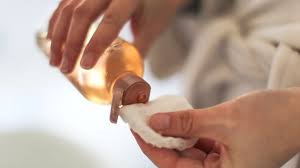
Astringents in Skin Care
Astringents are an important category of ingredients used in many skin care products. This blog discusses the definition of astringents and helps you find astringent skin care products. By causing a temporary tightening or toning effect on the skin, astringents can help minimize the appearance of pores, control oil production, soothe minor irritation, and give skin a smooth texture.
Common sources of plant-based and synthetic astringents include witch hazel, alum, sage, tea tree oil, aluminum acetate, and alcohol.
When used properly, astringents can be beneficial as toners, cleansers, aftershave products, and more by promoting a healthy, balanced complexion. But astringents are not good for some skin types, so you need to know your Baumann Skin Type before shopping for astringent containing skincare products.
Definition of Astringent
An astringent is defined as a chemical compound that can constrict body tissues. In skin care, the meaning of astringent is a substance that can cause temporary tightening or toning of the skin. They work by precipitating proteins in the outer layers of the skin to reduce oiliness and minimize the appearance of pores.
The Food and Drug Administration (FDA) defines astringents in their Skin Protectant Drug Products for Over-the-Counter Human Use as:
“…products applied to the skin or mucous membranes for a local and limited protein coagulant effect.”
This means astringents cause proteins in the skin to coagulate or clump together, resulting in tightening of the skin.
Chemistry
In broader chemistry, an astringent is any substance that can shrink or constrict body tissues. In the context of skincare, this typically means substances that tighten the skin and reduce oiliness. The term isn’t restricted to any specific chemical structure but rather refers to the effect the substance has on the skin or tissue.
How Astringents Work
Astringents work through a process called precipitating proteins. When applied to the skin, astringents chemically interact with the proteins in the outer layers of skin tissue. This causes the proteins to lose their solubility and clump together, resulting in the tightening effect.
By precipitating skin proteins and constricting pores, astringents also absorb water from the skin’s surface. Removing excess proteins and water causes the skin to contract and feel tighter.
How Astringents Tighten Skin
Astringents work by precipitating proteins in the outer layers of the skin through chemical interactions, causing the tissue to contract. This constricting action also absorbs water from the skin’s surface. Removing excess proteins and water tightens the skin.
Protein Denaturation: When applied to the skin, certain astringent ingredients can cause proteins (like keratin in the skin) to coagulate or denature. This results in a constricting or tightening effect, which can make the skin feel firmer and reduce the appearance of pores.
Constriction of Skin Tissue: Astringents can cause a temporary constriction of the skin’s tissues, leading to a tightened feeling.
Removal of Surface Oils: By removing oils from the skin’s surface, astringents can create a sensation of tightness.
pH Factor: The pH of an astringent can have an effect on the skin, but it’s not the primary reason for the skin tightening. That said, restoring the skin’s pH balance after cleansing can contribute to the overall health and feeling of the skin.
Dehydration: Astringents, especially those containing alcohol, can have a drying effect on the skin. While this can help reduce oiliness in the short term, it can also lead to dehydration of the skin’s surface, contributing to the sensation of tightness. However, this kind of tightness isn’t always beneficial, as over time it can lead to skin dryness and irritation.
Astringents and Alcohol: While many astringents contain alcohol , not all astringents are alcohol-based. There are many alcohol-free astringents on the market formulated with ingredients like witch hazel, rose water, or botanical extracts. These can be gentler on the skin while still providing some astringent benefits.
The skin-tightening effect of astringents is a combination of protein denaturation, tissue constriction, and the removal of surface oils. The sensation of tightness can also be influenced by changes in skin pH and dehydration, especially with alcohol-based astringents. Astringents aren’t always alcohol-based, and their defining characteristic is their skin-tightening effect rather than a specific chemical structure.
How Astringents Unclog Pores
The action of astringents on pores and their ability to unclog them is a combination of several factors:
Removal of Surface Oils and Debris:
Astringents can help remove excess oils (sebum) and debris from the skin’s surface. Overproduction of sebum combined with dead skin cells can lead to clogged pores, which can result in comedones (blackheads and whiteheads). By removing excess oil and debris, astringents can help reduce the likelihood of pores getting clogged.
Exfoliation:
Some astringents contain ingredients, like salicylic acid, which act as exfoliants. Exfoliants help in removing the dead skin cells that can accumulate and clog pores.
Salicylic acid, in particular, is lipophilic, meaning it’s attracted to oils. This property allows it to penetrate deeper into oil-filled pores, helping to unclog them from within.
Antiseptic Qualities:
Many astringents have antiseptic properties, meaning they can kill or inhibit the growth of bacteria on the skin. This is particularly valuable because bacterial growth within pores can lead to inflammatory acne.
For example, witch hazel, a common ingredient in many astringents, has both astringent and antiseptic properties, making it effective at keeping pores clean and reducing the likelihood of bacterial-induced breakouts.
Reduction in Pore Size:
By causing a temporary constriction of skin tissues, astringents can make pores appear smaller. While this doesn’t technically “unclog” a pore, it can make them less prone to accumulating debris simply by reducing their opening size.
Balancing Skin pH:
The skin’s natural barrier, known as the acid mantle, has a slightly acidic pH, which helps keep bacteria at bay and ensures proper functioning of enzymes responsible for skin health. By helping to balance the skin’s pH, some astringents can promote a healthier skin environment, making it less prone to clogging and breakouts.
Hydration:
While this may seem counterintuitive, some astringents contain hydrating ingredients or are followed up with moisturizers. Proper hydration can ensure that the skin sheds dead cells more effectively, preventing them from accumulating inside pores.
In summary, astringents in skin care can help unclog pores through a combination of cleaning surface oils and debris, exfoliating action, antiseptic properties, making pores appear smaller, balancing skin pH, and promoting effective skin hydration. However, it’s essential to select an astringent suited to your skin type and concerns and to use it in conjunction with other suitable skincare products for the best results.
Benefits of astringent ingredients
Benefits and Uses of Astringents
Astringents have several uses in skin care:
Tightening and toning pores – By precipitating proteins and absorbing water, astringents cause pores to tighten and appear smaller. This can reduce the appearance of large pores.
Reducing oiliness – Astringents remove excess sebum, dirt, and oil from the skin’s surface, leading to a less shiny complexion.
Minimizing puffiness – Constricting the skin can decrease minor puffiness and swelling, like under eye bags. Astringents are common ingredients in eye creams.
Treating minor skin irritations – Some minor skin issues, like insect bites, hemorrhoids, rashes, and acne can benefit from an astringent’s skin tightening abilities. The constricting effect helps reduce inflammation and irritation.
Skin Care Products
Astringents are most commonly found in:
Toners – Facial toners applied after cleansing contain astringent ingredients to help remove residue and tighten pores.
Essences – Like toners, essences often contain plant-based astringents to refine skin texture.
Products with alcohol
Alcohol reduces skin bacteria and shrinks pores but can be drying to some skin types.
Products with Sage
Sage is an antioxidant astringent. It is a natural ingredient to shrink pores.
Products with Witch Hazel
Witch hazel is a very popular astringent because of it’s anti-inflammatory abilities.
When To Use Astringents in Skin Care Routine
Astringents are applied to the skin after cleansing and before moisturizing. Using an alcohol-free astringent 1-2 times per day can help minimize pores, absorb oil, and create a smooth base for other products
astringent ingredients
List of Astringent Ingredients in Skin Care
Some plant-based and synthetic ingredients commonly used as astringents include:
Witch Hazel – Distilled from the witch hazel shrub, this natural astringent is gentle on sensitive skin.
Sage – An herb with antioxidant and astringent benefits. Often used in toners and aftershaves.
Aluminum acetate and aluminum sulfate – Synthetic ingredients used in commercial antiperspirants for their pore-tightening effects.
Alcohol – Ethyl alcohol provides an intense astringent effect by quickly drying the skin. Can be irritating.
Calamine – A mixture of zinc and iron oxides with astringent and skin-protective properties often used to treat poison ivy.
Comfrey – A healing herb used to treat wounds and irritation that also has mild astringent effects.
Black Tea – Black tea contains tannins that act as natural astringents when applied to the skin.
Alum – A type of mineral salt used as a natural astringent, often in shaving products.
Manjishtha – An Ayurvedic herb used to treat acne, skin inflammation, and blemishes.
Sandalwood – Sandalwood oil has antiseptic and astringent properties. Helps calm and tighten skin.
White Oak – The bark contains tannins that act as an astringent. Also has antibacterial effects.
Ginkgo – Ginkgo leaves contain flavonoids and terpenoids that provide antioxidant and astringent benefits.
Using the right astringent ingredients for your skin type can help refine pores, reduce shine, and give skin a smooth, toned appearance. When used properly, astringents can be beneficial additions to your daily skincare routine.


